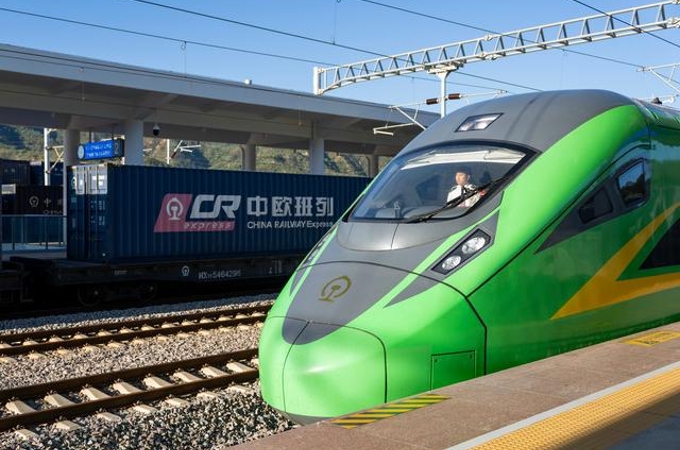China launches the Tianzhou 4 cargo spacecraft
Source: China Daily | 2022-05-10 | Editor:Amy
China's space program takes next step to the heavens
In the latest stage in its space station program, China launched the Tianzhou 4 cargo spacecraft early on Tuesday morning, to transport fuel and supplies to its Tiangong space station, according to the China Manned Space Agency, or CMSA.
In a brief statement, the agency said that a Long March 7 carrier rocket blasted off from the Wenchang Space Launch Center in Hainan province at 01:56 am, sending the robotic spaceship to a low-Earth orbit of around 400 kilometers. It docked with Tiangong travelling in that same orbit at 08:54 am.
Carrying nearly 6 metric tons of propellants and materials, including more than 200 packages, the Tianzhou 4 is tasked with supporting the upcoming Shenzhou XIV mission, during which a three-member crew is expected to stay six months inside the Tiangong station.
Currently, Tiangong consists of the Tianhe core module and the Tianzhou 3 craft. Its most recent occupants – three astronauts of the Shenzhou XIII mission – completed a six-month journey and returned to Earth in mid-April.
The Shenzhou XIV spacecraft will be launched next month from the Jiuquan Satellite Launch Center in northwestern China, Hao Chun, CMSA chief, said last month.
In July, the Tiangong station's first lab component -- Wentian, or Quest for the Heavens – will be launched, while the second lab named Mengtian, or Dreaming of the Heavens, will be sent to dock with the station in October, Hao said, adding that after they are connected with the Tiangong, the station will form a T-shaped structure.
After the space labs, the Tianzhou 5 cargo craft and the Shenzhou XV crew are scheduled to arrive at the massive orbiting outpost around the end of the year.
In the longer term, the station will be regularly connected with a Shenzhou spacecraft and two Tianzhou cargo ships, according to the official.
Tianzhou 1, China's first cargo spacecraft, was launched from the Wenchang Center in April 2017. It carried out several docking and in-orbit refuelling maneuvers with a Chinese space laboratory in a low-Earth orbit between April and September that year, enabling China to become the third nation capable of in-orbit refueling, after the former Soviet Union and the United States.
With a designed life of more than a year, each Taizhou cargo spaceship has two parts, a cargo cabin and a propulsion section. Such vehicles are 10.6 meters long and 3.35 meters wide.
The cargo vehicle has a lift-off weight of 13.5 tons, and can transport up to 6.9 tons of supplies to the space station.
You May Like
-
China to further tap consumption potential
China on Monday unveiled guidelines to further tap the country's consumption potential, with detailed measures to tackle short-term bottlenecks and boost longer...
InKunming 2022-04-26 -
116th joint patrol on Mekong River begins
Law-enforcement authorities from China, Laos, Myanmar and Thailand joined forces on Tuesday to start the 116th Mekong River joint patrol.
InKunming 2022-04-26 -
China accelerates research on key water conservancy technolo...
China will accelerate research on key water conservancy technology, involving 42 projects this year, the Ministry of Water Resources said.
InKunming 2022-04-25 -
China starts engineering development of lunar exploration pr...
China will start engineering development of the fourth phase of its lunar exploration program this year.
InKunming 2022-04-25 -
China (Kunming) Intellectual Property Protection Center pass...
On April 14, the expert group of the China National Intellectual Property Administration conducted an online acceptance of China (Kunming) Intellectual Property...
InKunming 2022-04-24 -
Boao Forum helps build consensus on global development
Boao provides a vital platform to further strengthen Australia's business and political relationships with Asia.
InKunming 2022-04-24 -
Feature: Renewing China-U.S. friendship on the Mississippi
China's Wanxiang Group earlier this week renewed its scholars program with Muscatine.
InKunming 2022-04-24 -
China-U.S. economic, trade relations win-win in nature
China-U.S. economic and trade relations are win-win in nature, and to restore normal trade ties between the two countries as soon as possible is the shared aspi...
InKunming 2022-04-24 -
Over 270,000 tons of cargo imported and exported in the firs...
According to Kunming Customs, about 276,000 tons of international cargo were imported and exported via the China-Laos Railway in the first quarter of 2022.
InKunming 2022-04-22 -
China's Gansu launches first int'l freight train via China-L...
A freight train departed Thursday morning from Dunhuang City, for Thailand's Bangkok.
InKunming 2022-04-22







